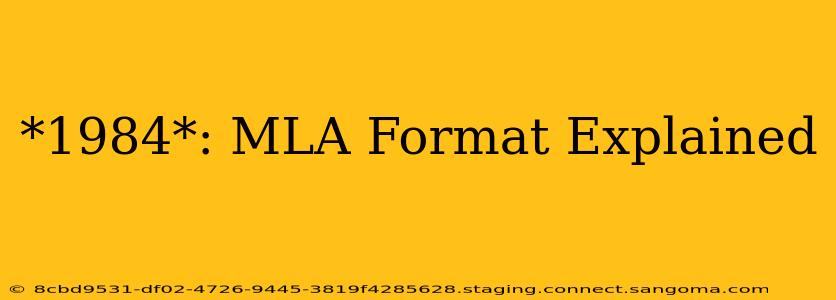George Orwell's Nineteen Eighty-Four (1984) is a dystopian masterpiece often studied in literature courses. Understanding how to properly cite this novel using Modern Language Association (MLA) format is crucial for academic integrity. This guide will walk you through the essential elements of MLA formatting for 1984, covering in-text citations, works cited entries, and addressing common questions.
How to Cite 1984 in MLA In-Text Citations
In-text citations in MLA format are brief references within your essay that direct the reader to the full citation in your Works Cited page. For 1984, the basic in-text citation depends on whether you're using a specific edition or a general reference.
General Reference: If your essay makes general references to the novel without specific page numbers (e.g., discussing overall themes), you only need to include the author's last name and the work's title (italicized) in the first reference. Subsequent mentions might only require the author's last name.
Example: Orwell's Nineteen Eighty-Four explores the dangers of totalitarianism. Orwell masterfully depicts the oppressive nature of the Party.
Specific Page References: When quoting or paraphrasing specific passages, you must include the page number(s) in your citation. This is especially important for direct quotes.
Example: The Party's control extends to every aspect of life, as Winston discovers: "The Party told you to reject the evidence of your eyes and ears. It was their final, most essential command" (Orwell 17).
Creating an MLA Works Cited Entry for 1984
The Works Cited page is a list of all the sources you referenced in your essay. The entry for 1984 will follow a specific format depending on the edition you used. Always use the most current edition information available. Below are examples for different scenarios:
Standard Edition: If you used a standard paperback or hardcover edition, the format will be:
Example:
Orwell, George. Nineteen Eighty-Four. [Publisher], [Year of Publication].
Specific Edition with Editor: If your edition includes an introduction or notes by an editor, include the editor's name.
Example:
Orwell, George. Nineteen Eighty-Four. Edited by [Editor's Name], [Publisher], [Year of Publication].
Different Medium (e.g., eBook): If you accessed 1984 through an ebook reader or online platform, include the platform information after the publisher.
Example:
Orwell, George. Nineteen Eighty-Four. [Publisher], [Year of Publication], [Platform, e.g., Kindle].
Frequently Asked Questions about Citing 1984 in MLA
What if I'm using a translation of 1984?
If you are using a translated version of 1984, you need to list the translator's name after the author's name. The format would be:
Example:
Orwell, George. Nineteen Eighty-Four. Translated by [Translator's Name], [Publisher], [Year of Publication].
How do I cite a specific chapter or section of 1984?
While not always necessary for general references, for more precise citations, you can include the chapter or section in your in-text citation. For example: (Orwell, Part 1, Ch. 1, 25)
What if I only refer to the novel’s general ideas?
In such cases, you don't need page numbers in your in-text citation. A simple (Orwell) is sufficient, particularly in subsequent references once you've already introduced the work.
Where can I find more detailed information about MLA formatting?
The official MLA Handbook provides the most up-to-date and detailed guidelines. Consult the latest edition for the most accurate and comprehensive information.
This guide provides a comprehensive overview of citing 1984 in MLA format. Remember to always double-check your citations against the most recent MLA guidelines to ensure accuracy and avoid plagiarism. Proper citation reflects scholarly rigor and acknowledges the original author's work.

